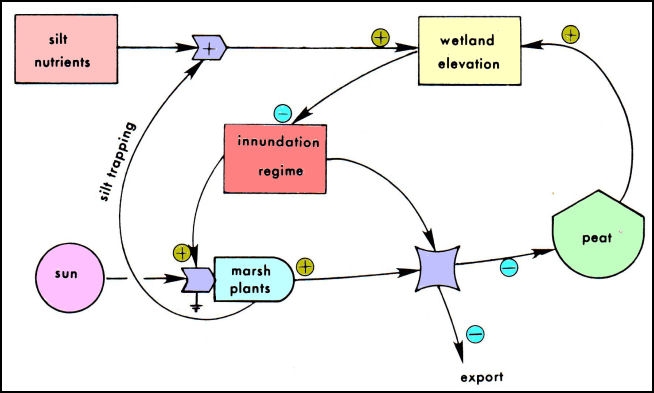The relationship of interactions between the hydrologic regime, marsh plants, and
sedimentation
characteristics in a hypothetical marsh is represented in the following figure.

The classical examples of bog succession, emphasize the feedback loop through which
organic
accumulation changes the hydrologic regime by raising the wetland elevation or blocking and
diverting earlier waterflows.The above diagram illustrates the reciprocal effects between wetland
ecosystems and hydrology. Plant production in the marsh yields organic matter that can become
deposited in sediment as peat or exported. Whether it is exported or deposited depends to some
extent on the inundation regime. That is, a high-energy hydrologic regime will carry much of the
production out of the marsh, but there are at leas ttwo feedback loops that modify this response. In
the first place, the vegetation of the marsh acts as a silt trap, particularly at the edge; this tends
to
increase the sedimentation rate and raise the elevation of the marsh. Second, as the marsh
elevation increases, the frequency and depth of flooding decrease so that less organic production is
exported and is instead deposited as peat. This deposition results in further increases in marsh
elevation. These two factors tend to cause a wetland to continue to grow upward until it reaches the
upper level of the flooding water; or in the case of ombrotrophic bogs, the elevation above which it
does not stay saturated. The buildup of biotic material increases peat production at the expense of
inorganic inputs. In the northern Minnesota peatlands. In this case, the surface vegetation was
shown to delineate ant, subsurface hydrology. accumulation was found to alter the hydrology,
since it acted as a barrier to percolation of surface waters.
Another feedback loop through the biota occurs with nutrients. As peat deposition
increases or silt
trapping increases, the marsh builds upward. The increase in elevation, and in total standing
biomass aboveground and peat underground, tend to close the nutrient cycle and less flux occurs
across the marsh boundaries.
Although the modification of the hydrologic regime and simultaneous biotic changes
may produce
dramatic instances of vertical succession (ombrotrophic bogs from minerotrophic wetlands), or
horizontal lakeshore succession from open water through grassed and wooded wetlands to raised
bogs, many more energetic wetland systems seem to be arrested in immature stages by the
pulsed inundation regime. Odum terms this "pulse stability" of fluctuating water-level ecosystems
and cites coastal tidal marshes and the Florida Everglades as examples. These systems cannot
mature because the flooding waters continually dilute them, preventing the accumulation of
biological information.

